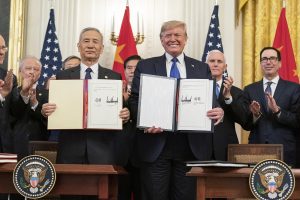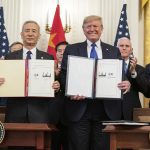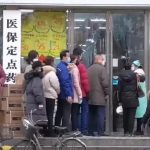Chapter By Chapter Look at Phase One Trade Agreement with China Part 3
 You could call this phase three of the Phase One Trade Agreement with China breakdown, but we won’t call this post that to avoid making it sound confusing. Still, this is the third part of our chapter by chapter look at the new deal.
You could call this phase three of the Phase One Trade Agreement with China breakdown, but we won’t call this post that to avoid making it sound confusing. Still, this is the third part of our chapter by chapter look at the new deal.
In the first part of this blog series, we gave a little background on the new trade deal with China (as well as a bit on USMCA). Then we took a look at the first four chapters of the Phase One Trade Agreement. These chapters dealt most with regulation in areas of particular concern for the U.S., like intellectual property.
In part two, we looked at chapters five and six. It was here we found the spending obligations China agreed to.
Today’s blog will wrap things up by getting into the last two chapters of the Phase One Trade Agreement with China, with chapter 7, deservedly so, getting a good deal of the attention. Finally, we’ll wrap this thing up with an overall conclusion.
I took the time to read the trade deal in its entirety and give my thoughts on it in these blog posts, but you don’t have to settle for my opinion on it. You can read the deal yourself by clicking here to go to the 91-page document published by the Office of the United States Trade Representative (USTR).
Chapter 7 — Dispute Resolution
The seventh chapter is an extremely important one in the trade deal with China and is titled Bilateral Evaluation and Dispute Resolution. Agreeing to do things is fine, but if there’s no mechanism to enforce following through with those commitments, a deal could ultimately not mean much. Chapter seven creates a mechanism for enforcement.
After an article to explain the purpose of chapter seven, the first thing the countries agree to in the chapter is to set up a Trade Framework Group, which includes the USTR and a Vice Premier of China, to meet on an ongoing basis to discuss the implementation of the agreement, problems with implementation, and arrange future work between the countries.
A group to discuss implementation may not sound like the strongest mechanism for enforcement. However, the agreement labels the paragraph discussing this group as “High-level Engagement,” and that is probably the main purpose of the group — to ensure high level government officials from both countries are involved in the trade partnership this trade deal lays out. Such a group is probably a necessary starting point — but, luckily, it is only the starting point when it comes to this implementation section.
Both countries are required to create a Bilateral Evaluation and Dispute Resolution Office that is open daily to do three things:
(a) assess specific issues relating to implementation of this Agreement, (b) receive complaints regarding implementation submitted by either Party, and (c) attempt to resolve disputes through consultations.
Articles in this chapter go on to give both countries the right to request information from the other that requires a response, establish a process of appeal if one country believes the other is not acting in accordance with the trade deal, and lay out how action can be taken if resolution to the complaint in appeal is not reached.
What really stands out to me in this section is the following line:
If the Party Complained Against considers that the action of the Complaining Party was taken in bad faith, the remedy is to withdraw from this Agreement by providing written notice of withdrawal to the Complaining Party.
This potentially is a way out of the trade deal. Here’s how that might look:
- China puts pressure on U.S. companies to transfer technology to Chinese companies (just an example).
- The U.S. submits an appeal to China’s Bilateral Evaluation and Dispute Resolution Office.
- China’s officials claim their assessment of the appeal shows the country’s actions do not violate the agreement.
- The U.S. takes the issue to China’s Vice Premier.
- Resolution is still not reach.
- The U.S. decides to invoke a tariff hike as a remedial measure.
- China says the tariff hike is done in bad faith, and gives written notice to withdraw from the trade agreement.
From reading article 7.5, it is possible for a faster process than what I just laid out to end the deal. The USTR or China’s Vice Premier could take an issue directly to the other without the lower appeal and assessment steps leading up to it, so the above sequences could start at number four. However, this also provides for a faster resolution of issues that arise, which is likely the intention.
An annex to the chapter puts timelines into place to resolve disputes: 10 working days to assess an appeal, 21 calendar days to reach an appeal resolution before the USTR and Vice Minister must be brought in, 45 calendar days from appeal date to reach resolution — which includes the time before and after the USTR and Vice Minister are brought in — and 30 calendar days to hold a meeting after it is requested by the complaining country if resolution is not reached.
If an urgent issue pops up, the USTR or China’s Vice Premier can request a meeting that is to be scheduled within 30 calendar days.
Because when I first started reading articles about the Phase One Trade Agreement with China, a big deal was made of the U.S.’s ability to impose tariffs if China does not follow through with its commitments, I think it’s worth noting that tariffs are not explicitly brought up in the chapter. Of course, they are not excluded, and tariffs have been President Trump’s go-to penalty to impose on China during the trade war. That makes tariffs a likely “remedy” the U.S. would use if resolution of an appeal was not reached.
However, the deal is open-ended on action the complaining party could take if the other country breaks the deal in some way. Here’s the language of the action the U.S. or China could take if the other does not follow through with its obligations under the agreement and a resolution is failed to be reached:
… the Complaining Party may resort to taking action based on facts provided during the consultations, including by suspending an obligation under this Agreement or by adopting a remedial measure in a proportionate way that it considers appropriate with the purpose of preventing the escalation of the situation and maintaining the normal bilateral trade relationship.
The important thing here is that measures imposed against the other country should be appropriate or in proportion to the action the complaining country has appealed. Therefore, escalation of tension should be avoided. However, deciding what is appropriate and in proportion is really up to the complaining party. The check to make sure the retaliation action really is proportionate is the ability of the other country to withdraw from the agreement with an argument that the remedy measure was taken in bad faith. Of course, leaving the agreement would likely reignite the trade war, and a strong bilateral trade relationship is beneficial for both countries.
In theory, the enforcement mechanism seems like a good one. Of course, we’ll have to watch to see how trade cooperation under this deal goes in practice.
Chapter 8 — Miscellaneous Provisions
Chapter 8 of the trade deal is actually titled Final Provisions. It is a short chapter that lays out some miscellaneous items like the countries may agree, in writing, to amend the Phase One Trade Deal and the annexes, appendices, and footnotes of the agreement are an integral part of it.
The most interesting thing I found in this section, beyond the ability amend the deal, is that it defines when the deal goes into force. That happens 30 days after signing, which would mean February 15th, or earlier, when the countries notify each other in writing of the completion of their respective applicable domestic procedures, if that should occur first.
The only other thing that grabbed my attention was the final article of the chapter, which reads simply, “The English and Chinese versions of this Agreement are equally authentic.”
That’s a pretty standard statement about both texts being authentic. It just made me think for a moment of the necessity for the Chinese translators for the U.S. and the English translators for the Chinese to do a meticulous job reading over the Chinese and English versions of the agreement to make sure there are no legal variations between the two.
Conclusion
The Phase One Trade Agreement with China appears to be an excellent deal for the U.S. As pointed out in the first two parts of this blog series, the deal is mostly full of concessions from China, addressing U.S. concerns about unfair trade practices between the countries and getting China to agree to import more goods from the U.S. to reduce the trade deficit between the countries. The latter should prove a boost to U.S. production and jobs. The former should open Chinese markets to American businesses in a fairer and more protected way.
The U.S. made concessions outside of the trade deal itself like removing the official label of currency manipulator from China and not implementing a scheduled set of tariff hikes back in December; however, most tariff increases President Trump has imposed on China remain in place.
At the heart of this agreement appears to be a striving for free and fair bilateral trade cooperation between the U.S. and China with the hope that trade disputes, should they arise, will be resolved without escalating tensions and trade war.
The Phase One Deal includes more than I expected when it was first announced that the trade deal with China would be broken into phases. Addressing intellectual property concerns, technology transfer abuses, agricultural bans, Chinese spending on U.S. goods, and more while the biggest U.S. concessions were removing some, but not nearly all, tariffs and a label that were imposed by President Trump in order to get a trade deal to address these issues in the first place suggests strong negotiation from the U.S. It also provides optimism for a Phase Two Trade Agreement down the road.
Additionally, if you’re a U.S. producer of goods, this deal makes it a good time for you to look into exporting to China.




